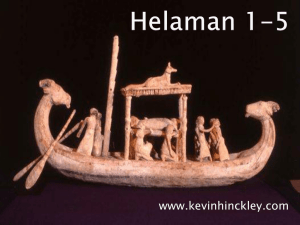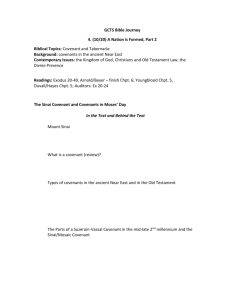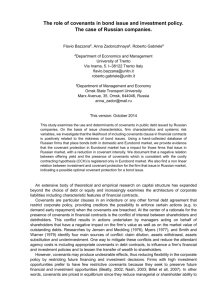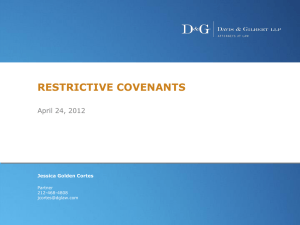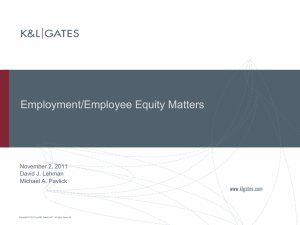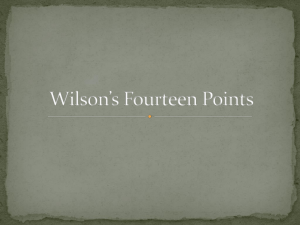Covenant Runs with Land
advertisement
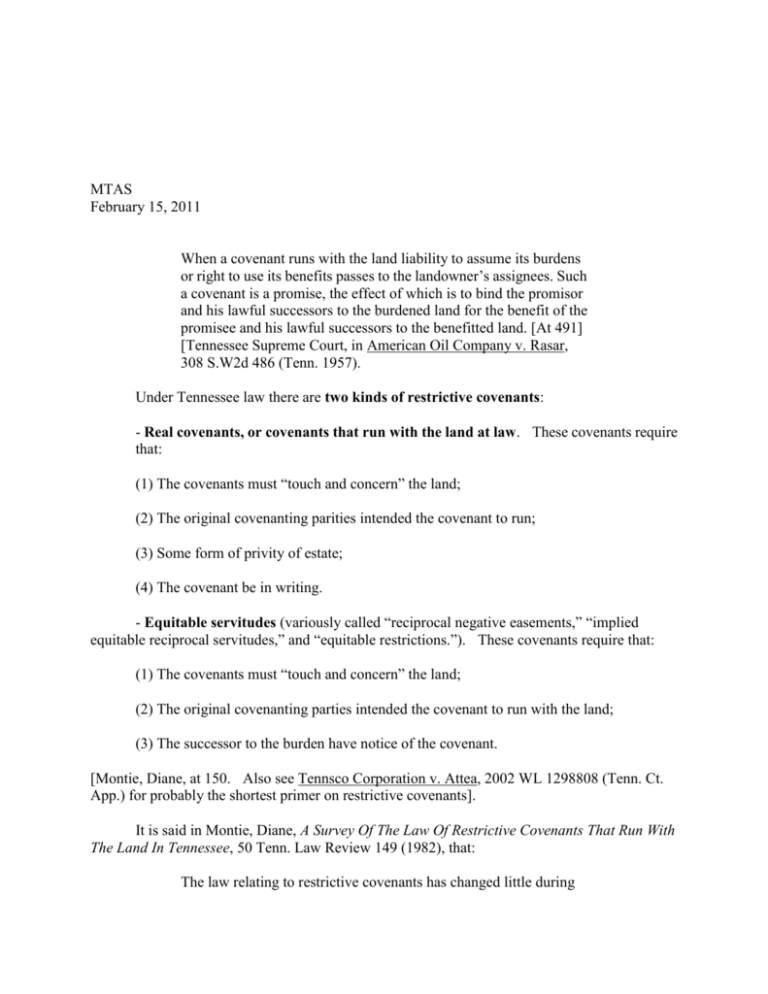
MTAS February 15, 2011 When a covenant runs with the land liability to assume its burdens or right to use its benefits passes to the landowner’s assignees. Such a covenant is a promise, the effect of which is to bind the promisor and his lawful successors to the burdened land for the benefit of the promisee and his lawful successors to the benefitted land. [At 491] [Tennessee Supreme Court, in American Oil Company v. Rasar, 308 S.W2d 486 (Tenn. 1957). Under Tennessee law there are two kinds of restrictive covenants: - Real covenants, or covenants that run with the land at law. These covenants require that: (1) The covenants must “touch and concern” the land; (2) The original covenanting parities intended the covenant to run; (3) Some form of privity of estate; (4) The covenant be in writing. - Equitable servitudes (variously called “reciprocal negative easements,” “implied equitable reciprocal servitudes,” and “equitable restrictions.”). These covenants require that: (1) The covenants must “touch and concern” the land; (2) The original covenanting parties intended the covenant to run with the land; (3) The successor to the burden have notice of the covenant. [Montie, Diane, at 150. Also see Tennsco Corporation v. Attea, 2002 WL 1298808 (Tenn. Ct. App.) for probably the shortest primer on restrictive covenants]. It is said in Montie, Diane, A Survey Of The Law Of Restrictive Covenants That Run With The Land In Tennessee, 50 Tenn. Law Review 149 (1982), that: The law relating to restrictive covenants has changed little during February 15, 2011 Page 2 the last one hundred years in Tennessee, but the reasons for using restrictive covenants have changed to reflect a more complex society. Historically, the usual purpose of restrictive covenants was to protect the grantor’s residence. Today, the use of the land is more complex. Subdivisions, condominiums, apartments, and single family residences require diversified land use planning to protect those communities of purchasers [At 149] One of the modern complexities of the development of land, for whatever its intended use, is that such development is subject to stormwater management requirements. A tool for managing stormwater that appears in stormwater regulations is the maintenance agreement for the stormwater facilities that appear in developments. Those maintenance agreements commonly contain restrictive covenants that run with the land, that obligate both present and subsequent owners of the property to continue the maintenance of the stormwater facilities. For example, the Knox County Stormwater Maintenance Manual contains a document entitled COVENANTS FOR PERMANENT MAINTENANCE OF STORMWATER FACILITIES, which contains various covenants the property owner must agree to as a condition of the development of his property. Paragraph 5 provides that: To ensure that subsequent property owners have notice of these Covenants and the obligations therein, the Property owner will include in all instruments conveying any or all of the above described property on which the stormwater and/or water quality facilities are located, the specific instrument numbered referencing these Covenants and the recorded subdivision plat as indicated in paragraph 12 herein. Paragraph 11 provides that “These Covenants are permanent and shall run with the land.” Similar documents are used by cities and counties across Tennessee and in other states. Such maintenance agreements that run with the land raised at least two questions in the stormwater seminars held last year: 1. What is the legal status of such agreements, applying as they do, to the subsequent development of property. For reasons that will appear below. generally, restrictive covenants containing stormwater infrastructure maintenance arising from new property development mandates and agreements between local governments and developers will reflect real covenants running with the land at law. However, where, for some reason, the restrictive covenant fail the real covenants test, equity might, depending on the circumstances, intervene to impose the covenant as an equitable servitude. February 15, 2011 Page 3 2. What is the legal status of such agreements with respect to property that has already been developed? Generally, for reasons that will appear below, such agreements with respect to such property will probably neither qualify as real covenants that run with the land at law, nor as an equitable servitude. Restrictive covenants are contracts between the parties to them Restrictive covenants are contracts between the parties to them. Maples Homeowner’s Association, Inc. v. T & R Nashville Limited Partnership, 993 S.W.2d 36 (Tenn. Ct. App. 1999) says on that subject: Covenants, conditions and restrictions such as the ones contained in the Maples Declarations are property interests that run with the land. [Citations omitted by me.] They arise, however, from a series of overlapping contractual transactions. [Citations omitted by me.} Accordingly, they should be viewed as contacts. [Citations omitted by me.], and they should be construed using the rules of construction generally applicable to the construction of other contracts ... [Citations omitted by me.] The courts enforce restrictive covenants according to the clearly expressed intentions of the parties manifested in the restrictions themselves. [Citations omitted by me.] We give the terms used in restrictions their fair and reasonable meaning... [Citations omitted by me.], and we decline to extend them beyond their clearly expressed scope. [Citations omitted by me.] We also construe the terms of a restriction in light of the context in which they appear. When the restrictions terms are capable of more than one construction, we should adopt the construction that advances the unrestricted use of the property. [Citations omitted by me.] We should also resolve ambiguities in the restrictions against the party who drafted them ... [Citations omitted by me.], and finally we should resolve all doubts concerning covenant’s applicability against the covenant. [Citations omitted by me.] [At 38-39] While the Maples Declarations were part of a property development scheme that reflected real covenants that ran with the land at law, the contractual aspect of restrictive covenants applies to both kinds of restrictive covenants. We will see below that equitable servitudes reflect the intent of the original covenanting parties even where that intent does not necessarily appear in one or more deeds in the chain of title reflecting the conveyance of the property at issue. February 15, 2011 Page 4 It is also said in Gambrell v. Nivens, 275 S.W.3d 429 (Tenn. Ct. App. 2008), that: An owner of land may may sell portions of it and make restrictions as to its use for the benefit of himself as well as for the benefit of those to whom he sells. [Citations omitted by me.] Even though Tennessee law does not favor private restrictions upon the use and enjoyment of land, our courts will enforce the covenants as they would contracts, according to the clearly expressed intention of the parties. [Citations omitted by me.] Covenants that fail the more exacting requirements for real covenants at law may still be enforced in equity as an equitable servitude. An equitable servitude is a “covenant respecting the use of land enforceable against successor owners or possessors in equity regardless of its enforceability at law.” [Citation omitted by me.] [At 436-37] Distinguishing between the two kinds of restrictive covenants and identifying what they have in common It was said in Turnley v. Garfinkel, 362 S.W.2d 921, that: It is a common practice for developers of high-class residential subdivisions to provide restrictions to protect the beauty of the neighborhood and the value of the property for residential use. Such restrictions are usually regarded as covenants running with the land, binding on anyone who purchases with notice of them, and enforceable by the owner of any of the lots so protected.... [At 923] The Court appears to have been speaking of covenants that run with the land at law. As the Court itself noted, the lots were part of a subdivision approved by the Davidson County Planning Commission and recorded in the registrar’s office, and that the subdivision’s developer had filed a set of restrictive covenants that were referred to and made a part of the deeds conveying the lots at issue. There were 11 covenants “and provide that they are deemed covenants running with the land until December 1985.” Citing that case, Maples Homeowner’s Association, Inc., above, declared that, “Covenants, conditions and restrictions such as the ones contained in the Maples Declarations are property interests that run with the land.” [At 38-39] The “Maples Declarations involved a planned unit development named The Maples under the Horizontal Property Act, codified in Tennessee Code Annotated, §§ 66-27-101-123. In describing The Maples Declarations, the Court declared that: February 15, 2011 Page 5 The Maples Declarations contain a fairly standard set of land use restrictions as well as a mechanism for their enforcement. They establish a homeowner’s association whose membership consists of the “owners of lots” in The Maples, and Article VII(1) provides in part: The Association, or any Owner, shall have the right to enforce, by any proceedings at law or in equity, all restrictions, conditions, covenants, reservations, liens and charges now or hereinafter imposed by the provisions of this Declaration. [At 37] [Emphasis is mine.] Montie, Diane, above says, “The restrictive covenant is generally created by a specific grant in a deed or by reference in a deed to a general plan of development.” [At 150] The touch and concern requirement With respect to the “touch and concern” requirement, it is said in Gambrell v. Nivens, 275 S.W.3d (Tenn. Ct. App. 2008), that: Although there is some dispute among authorities as to the test [that the covenant must “touch and concern” the land, there is little question that building restrictions embodied in a covenant between owners in fee satisfy this test, both as to the benefit and the burden. [Citing unreported Attea v. Tennsco, 2002 WL 1298808 (Tenn. Ct. App.). Also see Arthur v. Lake Tansi Village, Inc., 590 S.W.2d 923 (Tenn. 1979). Intention of parties that covenant run with the land With respect to the requirement that the covenanting parties intended that the covenant run with the land, it is further said in Gambrell, above, that: The covenants in Tennsco and Essary failed to express a substantive element of a real covenant at law: the intent to bind the successors, heirs, and assigns. Equity requires proof of the same substantive intent but does not confine the scope of inquiry to the language of the covenant itself. Nonetheless, Tennsco and Essary together stand for the proposition that our courts will broaden the scope of inquiry only where the vendor imposed the restrictions according to February 15, 2011 Page 6 a general plan of development. A development plan logically supports a finding that the parties intended the covenant to run with the land and bind the grantees’ successors, assigns and heirs. The very concept of a development plan and the subsequent expectations of the purchasers require the individual burdens and their corresponding benefits to inhere in the land and to benefit and bind whoever occupies that land. This much seems implicit, for a common plan would crumble if the burdens and benefits were merely personal to the contracting parties. [At 441-42] [Emphasis is mine.] In Essary v. Cox, 844 S.W.2d 169 (Tenn. Ct. App. 1992), the Essarys owned a service station, and on an adjoining lot, a convenience store. They sold the convenience store the deed to which contained this covenant: “It is expressly understood and agreed that the above described premises [the convenience store] shall not be used for the purpose of any sales of oil and gas supplies or products.” The convenience store was subsequently resold several times, the deeds to which contained mention of the covenant. But on the sale of the convenience store to Cox in 1989, the deed, at the request of Cox, did not contain the covenant. In 1985, the Essarys had also sold their service station adjacent to the convenience store, to their children. The Essary children subsequently sued Cox for selling oil and gas supplies from the convenience store in violation of the “restrictive covenant” that appeared in the first deed of sale of the convenience store. The court held that there was not a restrictive covenant running with the land, for two reasons: First, the covenant in the deed of the first sale of the convenience store by the Essarys did not contain language indicating that it applied to “the parties successors and assigns, i.e remote grantees.” The Court pointed to Lowe v. Wilson, 250 S.W.2d 366 (1952), in which the Tennessee Supreme Court had held that even this language in a deed did not qualify as a restrictive covenant: It is hereby agreed and understood between the parties hereto that no beer, beverages, or intoxicants of any kind or character shall ever be sold upon the lot or parcel of land herein conveyed, and this agreement is a part of the consideration for this sale. [At172] Second: In cases involving a common development plan, therefore, courts have demonstrated a willingness to enforce restrictive covenants, in the form of equitable servitude, under the rationale that a remote grantee’s knowledge of such restrictions may be imputed from the existence of a common plan as evidenced in deeds or on the plat February 15, 2011 Page 7 itself....Outside the context of restrictions which evidence a common development plan, however, Plaintiffs have cited no authority in this jurisdiction for the proposition that restrictive covenants may be imposed on remote grantees based upon their knowledge of the existence of a prior restriction. [At 171] In Tennsco, above, the Daugherty’s owned a large piece of property north of Cool Springs Shopping Center in Williamson County, in the middle of which their historic home sat. They sold the property north and south of their home to Wills, “effectively dividing the property into three parts,” according to the Court. The Daugherty’s deed to Wills contained this restriction: This conveyance is made subject to the restriction that any buildings constructed on the land shall be single family dwellings of traditional design at least 4,000 square feet in size and on lots of one (1) acre or more. Wills subsequently quit-claimed the property to Mallory Park, “subject to all restrictions, easements and encumbrances or [sic] record.” Park gave Tennsco a deed of trust to secure a loan. He defaulted on the loan and conveyed the property to Tennsco, but the deed did not contain those restrictions. Two conveyances later, the property ended up in Attea’s hands, and he attempted to enforce the restrictions contained in Daugherty’s deed to Wills. The Court held that the restriction did not operate as a restrictive covenant that ran with the land. It met the requirement for a real covenant that ran with the land at law as to the “touch and concern” requirement because the covenant was a building restriction. But it failed the intent of the original covenanting parties that the covenant run with the land because the covenant did not include the magic words that it bound the heirs and assigns of the grantees. As to the enforceability of the restrictions as equitable servitude, the Court said: Therefore, in order to enforce an equitable servitude or a reciprocal negative easement it must appear that the grantor had in mind a general plan of development and intended for the restrictive covenant to benefit all the property involved [At 3] [Citations omitted.] It also declared that: We think the undisputed facts show that there was no general plan or scheme of development adopted to cover the property held by the Daughertys.’ As the trial judge observed there was no map or sales brochure showing the restriction. And there is no restriction on the February 15, 2011 Page 8 property the Daughertys retained. When they conveyed the property to the Butters, they did not include any restrictions. Since, there was no reciprocal easement, the conclusion is inescapable that the restriction placed in the Wills deed was personal to the Daughertys. [At 3] That general rule applies in Tennessee, to both types of restrictive covenants. The Tennessee Supreme Court said in Land Developers v. Maxwell, 537 S.W.2d 2d 904 (Tenn. 1976), that: Ordinarily when the owner of a tract of land subdivides it and sells different lots to separate grantees, and puts in each deed restrictions upon the use of the property conveyed, in accordance with a general building improvement or development plan, such restrictions may be enforced by any grantee against any other grantee. Likewise, the property remaining in the hands of the vendor may also be held in equity to be subject to a servitude so as not to be used in a manner different from that contained in the restrictions..... This rule was recognized in this state in the leading case of Ridley v. Haiman, 164 Tenn. 239, 47 S.W.2d 750 (1932)... It appears that the Court was speaking of two classes of restrictive covenants: The first is those put in each deed to each grantee of separate lots, “in accordance with a general building, improvement or development plan....” and which appear to meet all the requirements of covenants that run with the land at law; and the property remaining in the hands of the vendor which “may also be held in equity to be subject to a servitude so as not to be used in a manner different from that contained in the restrictions.” In this case, the Court held that: Upon the facts shown in this record, we have no hesitancy in holding that the unsold lands of Mr. M.L.Tipton, and his corporation, here in issue, were restricted in his hands by essentially the same covenants as he had imposed in the deed to his various grantees, by an equitable servitude because there seems to be little question but that he did intend a general plan of development of the entire area as a residential ‘suburb’ or subdivision. [At 913] When do restrictive covenants take effect? It is said in East Sevier County Utility District of Sevier County v. Wachovia Bank & Trust Company, 570 S.W.2d 850 (Tenn. 1978), that: Likewise, petitioner now concedes that none of the restrictive February 15, 2011 Page 9 covenants could be given retroactive effect, absent an express contract so providing, although its contentions in the trial court in that regard were unclear and seem to have been to the contrary....We have already stated that no set of covenants should be given any general retroactive effect. [At 852-53] Southern Advertising Co. Inc. v. Sherman, 38 S.W.2d 491 (Tenn. Ct. App. 1957), also declares that: If it is a covenant running with the land, at least in the absence of an expressed contrary intention, its operation must be confined to the property as it existed at the time of the covenant. And the rule of strict construction applies when an attempt is made to apply the covenant to other lands. [At 493] Remedies for the violation of both kinds of restrictive covenants It is said in Monte, Diane, that, “A complainant can sue either at law or equity to enforce restrictive covenants.” At law, the remedy for the violation of restrictive covenants that run with the land at law is damages. At equity, the remedies of specific performance and injunction have been used to enforce restrictive covenants. But that distinction appears to be meaningless. In most of the Tennessee cases in which the violation of restrictive covenants is an issue by far the most requested remedy in both kinds of covenants, is the enforcement of the restrictive covenants rather than damages. A large number of those cases requesting the enforcement of restrictive covenants involve alleged covenants that do not qualify as real covenants that run with the land at law, but where the court is being asked to find a restrictive covenant in the form of an equitable servitude.
